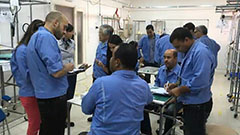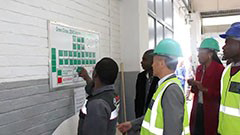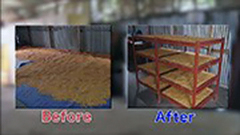JICA's technical cooperation and "Kaizen"

The number of African countries have been conducting Kaizen dissemination technical cooperation projects is accumulated up to 9. In addition to the technical cooperation projects, Kaizen training is being provided to 27 countries in Africa.
"Kaizen" is a method developed and evolved at Japanese manufacturing factory sites for improving quality and productivity. JICA-Net multimedia-based learning material, "An Overview of Kaizen, its Introduction and Disseminations" (YouTube, external link) , introduces and explains: (1) an overview of Kaizen, (2) dissemination of Kaizen, (3) Kaizen-related human resource development, and (4) specific cases of Kaizen in Africa and other countries.
In 1983, JICA started its technical cooperation to improve Japanese-style quality and productivity in Asia. In 2006, a first Kaizen technical cooperation in Africa started. The number of African countries have been conducting Kaizen dissemination technical cooperation projects is accumulated up to 9. In addition to the technical cooperation projects, Kaizen training is being provided to 27 countries in Africa.
JICA published "Kaizen Handbook" in 2018 for the purpose of dissemination of Kaizen. Along with the structure of the Handbook, this video material explains an overview and specific cases of Kaizen in order to enhance understanding and utilization of Kaizen.
The material is practical and has multiple language versions
The core value of Kaizen is placed in creating the attitude shared among all members of an organization who consistently pursue advanced levels of quality and productivity and not just applying its management method. In other words, everyone is equipped with knowledge and skills on improvement in quality and productivity.
Looking back on Japan's history of Kaizen activity becoming a large driving force in the period of high economic growth and the process of Kaizen dissemination and development in overseas countries, the material explains the essence, the characteristics, and the concrete approach of Kaizen with illustrations. In addition, including specific cases in each country, we produced the material for people to understand Kaizen effectively.

KAIZEN, which was born in Japan has been favorably received in countries around the world that face problems in productivity and competitiveness.
Because we currently focus on Africa and Latin America, where the dissemination of Kaizen has been proceeding, we prepared the French and Spanish versions in addition to the Japanese and English versions of the material. Moreover, there is a full version (30 minutes long) and a digest version (6 minutes long) for each language to be utilized according to the usage situation.
Under the restricted situation where it was difficult to do shooting at the local site because of COVID-19, the material has been produced efficiently by using remote interviews and so on.
We also consider the use of a more neutral vocabulary due to the slight language differences that occur in countries where the same language is spoken, for example, in French-speaking countries, there are certain situations where some countries use different words to refer to the same term.
Kaizen, which can be utilized in several areas
The material is expected to be utilized by organizations/companies which are interested in Kaizen as well as JICA projects and training programs.
Already, the material is starting to be used in the pre-dispatch training of Japan Overseas Cooperation Volunteers (JOCV), which applies Kaizen in various activities, and the training for consultants to strengthen their abilities in the field of private sector development.
Kaizen is universal enough to contribute to all industries. For example, there are many cases in which Kaizen has been applied to the medical workplace. We expect it might be useful in more industries in the future.

This is a factory in Ethiopia. In 2010, this workshop was in a cluttered state. However, when we came back to check it out, the tools were put in place. Moreover, the company's business performance is far better than it was in the past.
Although people may think that Kaizen is an old approach, it is accepted as a new approach in African countries. Because it is a scientific approach emphasizing on data-driven statistical quality management, it is said to be highly compatible with the progress of digitalization in recent years. Kaizen itself also has been improving itself every day.
HOMMA Toru
Senior Advisor (Private Sector Development)
Japan International Cooperation Agency (JICA)
*The Material(s) mainly applied
An Overview of Kaizen, its Introduction and Dissemination
"Kaizen" is a method developed and evolved at Japanese manufacturing factory sites for improvement of quality and productivity. This video material introduces and explains: (1) an overview of Kaizen, (2) dissemination of Kaizen, (3) Kaizen-related human resource development, and (4) specific cases of Kaizen in Africa and other countries. JICA published "Kaizen Handbook" in 2018 for the purpose of dissemination of Kaizen. Along with the structure of the Handbook, this video material explains an overview and specific cases of Kaizen in order to enhance understanding and utilizing of Kaizen. This video material is expected to be utilized by organizations/companies which are interested in Kaizen as well as JICA projects and training programs.




scroll